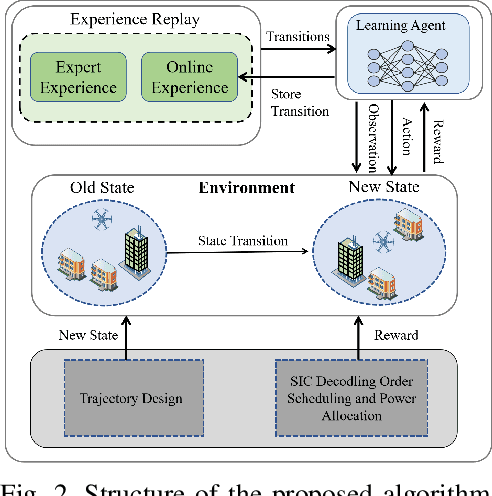Zhaolong Ning
Joint User Association, Interference Cancellation and Power Control for Multi-IRS Assisted UAV Communications
Dec 08, 2023



Abstract:Intelligent reflecting surface (IRS)-assisted unmanned aerial vehicle (UAV) communications are expected to alleviate the load of ground base stations in a cost-effective way. Existing studies mainly focus on the deployment and resource allocation of a single IRS instead of multiple IRSs, whereas it is extremely challenging for joint multi-IRS multi-user association in UAV communications with constrained reflecting resources and dynamic scenarios. To address the aforementioned challenges, we propose a new optimization algorithm for joint IRS-user association, trajectory optimization of UAVs, successive interference cancellation (SIC) decoding order scheduling and power allocation to maximize system energy efficiency. We first propose an inverse soft-Q learning-based algorithm to optimize multi-IRS multi-user association. Then, SCA and Dinkelbach-based algorithm are leveraged to optimize UAV trajectory followed by the optimization of SIC decoding order scheduling and power allocation. Finally, theoretical analysis and performance results show significant advantages of the designed algorithm in convergence rate and energy efficiency.
Intelligent-Reflecting-Surface-Assisted UAV Communications for 6G Networks
Oct 31, 2023Abstract:In 6th-Generation (6G) mobile networks, Intelligent Reflective Surfaces (IRSs) and Unmanned Aerial Vehicles (UAVs) have emerged as promising technologies to address the coverage difficulties and resource constraints faced by terrestrial networks. UAVs, with their mobility and low costs, offer diverse connectivity options for mobile users and a novel deployment paradigm for 6G networks. However, the limited battery capacity of UAVs, dynamic and unpredictable channel environments, and communication resource constraints result in poor performance of traditional UAV-based networks. IRSs can not only reconstruct the wireless environment in a unique way, but also achieve wireless network relay in a cost-effective manner. Hence, it receives significant attention as a promising solution to solve the above challenges. In this article, we conduct a comprehensive survey on IRS-assisted UAV communications for 6G networks. First, primary issues, key technologies, and application scenarios of IRS-assisted UAV communications for 6G networks are introduced. Then, we put forward specific solutions to the issues of IRS-assisted UAV communications. Finally, we discuss some open issues and future research directions to guide researchers in related fields.
Trustworthy Edge Machine Learning: A Survey
Oct 27, 2023Abstract:The convergence of Edge Computing (EC) and Machine Learning (ML), known as Edge Machine Learning (EML), has become a highly regarded research area by utilizing distributed network resources to perform joint training and inference in a cooperative manner. However, EML faces various challenges due to resource constraints, heterogeneous network environments, and diverse service requirements of different applications, which together affect the trustworthiness of EML in the eyes of its stakeholders. This survey provides a comprehensive summary of definitions, attributes, frameworks, techniques, and solutions for trustworthy EML. Specifically, we first emphasize the importance of trustworthy EML within the context of Sixth-Generation (6G) networks. We then discuss the necessity of trustworthiness from the perspective of challenges encountered during deployment and real-world application scenarios. Subsequently, we provide a preliminary definition of trustworthy EML and explore its key attributes. Following this, we introduce fundamental frameworks and enabling technologies for trustworthy EML systems, and provide an in-depth literature review of the latest solutions to enhance trustworthiness of EML. Finally, we discuss corresponding research challenges and open issues.
 Add to Chrome
Add to Chrome Add to Firefox
Add to Firefox Add to Edge
Add to Edge